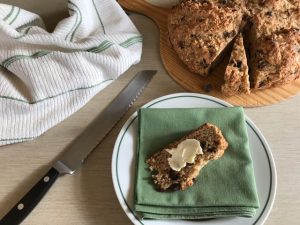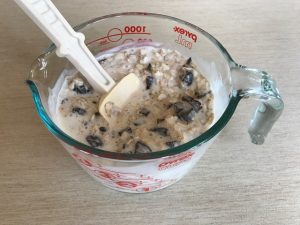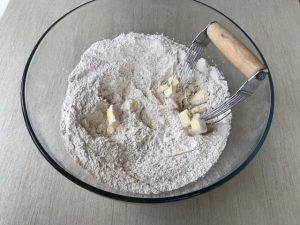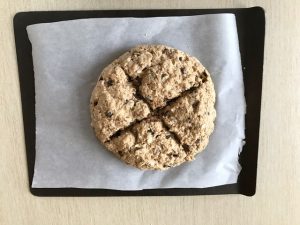Irish Soda Bread with Figs and Oats
I don’t like corned beef. My excuse for not serving it on St. Patrick’s Day is that it’s not really an Irish dish, although it may be served to tourists visiting Ireland. Corned beef was an Irish-American substitute for Ireland’s bacon and cabbage (1).
I do like Irish Soda Bread, but it didn’t originate in Ireland, either. According to The Society for the Preservation of Irish Soda Bread and others (2,3), the earliest evidence of chemical leavening to bake bread was by American Indians, prior to the 1800s. They mixed a natural soda from wood ashes with an acidic ingredient to leaven bread and baked it on hot stones. The first soda bread recipe in Ireland dates to 1836. It was a thrifty way to make bread for a hungry family using simple ingredients – flour, salt, baking soda, water and buttermilk.
American Irish soda bread has evolved to include butter, sugar, sometimes eggs, raisins and caraway seed or other flavorings. My version, created this year for the Valley Fig Growers Fig Focus Newsletter, combines rolled oats, a very Irish ingredient, buttermilk, whole grain flours and diced figs. Soaking the oats and figs in buttermilk helps to make a tender, moist bread.
Celebrating with a little Irish whiskey or stout? Soak it up with a sliver of wholesome Irish Soda Bread.
Happy St. Patrick’s Day.
Irish Soda Bread with Figs and Oats
Makes 1 loaf (12 to 16 slices.)
2 cups buttermilk (reduced-fat or regular)
1 cup Blue Ribbon® Orchard Choice® or Sun-Maid® California Figs, stemmed and chopped
2 cups old fashioned rolled oats, divided
1 1/2 cups all-purpose flour
1 cup white whole wheat flour
½ cup whole wheat pastry flour or cake flour
3 tablespoons granulated sugar
1 ½ teaspoons cream of tartar
1 ½ teaspoons baking soda
1 teaspoon salt
3 tablespoons unsalted butter, at room temperature
1. In a medium bowl, combine buttermilk, chopped Figs and oats. Set aside to soften for 1 hour.
2. Adjust rack to middle position. Preheat oven to 400°.
3. In a separate large bowl, combine all-purpose flour, whole wheat flour, whole wheat pastry flour, sugar, cream of tartar, baking soda and salt. With pastry blender or clean fingers, mix in butter till butter is the size of small peas. Add Fig-buttermilk mixture, stirring to form a soft dough.
4. With lightly floured or oiled hands, knead the dough (it will be sticky) in the bowl, about 10 turns, and form it into a ball. (Or, turn dough out onto a lightly floured surface to knead).
5. Place ball of dough on a parchment-lined or oiled, foil-lined baking sheet. Pat to a 7-inch diameter circle. With a knife, cut a cross in the top of the bread.
6. Bake for 23 to 28 minutes, or until golden brown and cooked through, covering with foil after 15 to 20 minutes to prevent over-browning. Bread is
done with internal temperature reaches 190° measured with an instant-read thermometer. Cool thoroughly on wire rack before slicing.
Tips:
- To measure flour, stir it with a spoon, spoon it into a measuring cup and level with a straight edge.
- For a tender loaf, avoid over-handling the dough or adding extra flour.
- For a more American version of soda bread, increase the sugar to 4 tablespoons and add a tablespoon of caraway seed.
References
- Corned Beef on Wikipedia
- The Society for the Preservation of Irish Soda Bread
- Food History, The Kitchen Project
© 2017 Lorelle Del Matto




 About lorelle
About lorelle
Speak Your Mind